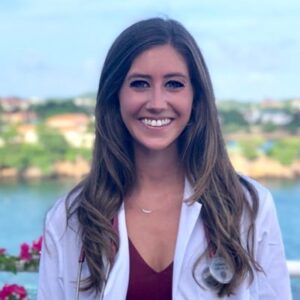Takeaway
Always remember that your patient is a person with a family, friends, and a unique story. Your first responsibility as a healthcare professional is to heal your patient and your second is to learn.

Passion in the Medical Profession | January 28, 2021 | 3 min read
By Shauna Maty, MPH, Medical Student, St. George University
It was my second-to-last shift as an EMT student in the ER of a hospital in Aurora, Colorado. It was busy and I was excited. In the back of my mind, especially as a student so eager to learn, I found myself perversely hoping for “something” traumatic to come through the doors.
As I placed an IV into a newly admitted patient, one of the nurses called out my name as she ran past: “We have someone coming in via helicopter if you want to come with us to meet them on the roof. An MVA patient.” Motor vehicle accident. Flight for life.
The ER was quickly flooded with personnel. Clinicians moved swiftly around each other in the small room, shouting out necessary information to their colleagues. IV bags of fluid and blood were hung and vitals were checked with the goal of stabilizing the patient long enough to rush her to the OR for emergency surgery. 10 minutes into the organized chaos, her blood pressure dropped, her oxygen level plummeted, and her heart ceased to rhythmically pulse on its own. The attending ER doctor tersely instructed me to begin chest compressions.
I’d done compressions a hundred times on the CPR dummies in class. I knew the approximate depth and tempo I should be doing. What I wasn’t prepared for was the feeling of clammy skin beneath my intertwined hands and the cracking of ribs as I placed my entire body weight behind my locked elbows and pushed down in the center of her chest, letting it recoil each time. “One and two and three and four and . . .”
We pumped 10 units of blood into our patient but her blood pressure remained dangerously low. Her heart slowly surrendered to the trauma it had endured. I watched silently as the green line on the heart monitor zigzagged up and down haphazardly before it sunk into a steady flat line.
The trauma surgeon quickly made a horizontal incision on the left side of her chest, pried it open with a shiny metal clamp, and then manually pumped her heart. He had his hand deep in the woman’s chest and squeezed rhythmically, trying to bring this woman back to life. Minutes passed and the green line stubbornly refused to move.
“Time of death—18:43.”
Silence filled the room. The surgeon told me to grab a glove. I looked down at the cut flesh splayed open on the table, the woman’s ribs and skin held back like curtains exposing the inside of her chest. He motioned me to put my hand in her chest. I felt for a fist-sized ball of muscle—her heart. I placed my whole hand around it and every so often I felt it pulse—the residual epinephrine was still having an effect—empty heart beats that didn’t give hope for life beyond this room.
Afterward, I found my classmates and immediately started gushing about the experience. My first time witnessing a real trauma case, first time performing CPR, first time seeing a chest cracked open, and first time touching a human heart. My adrenaline rush wouldn’t subside.
When my shift ended I wandered back to the room where my incredible “firsts” had occurred. The lights were dim and everything was quiet. The woman lay on the gurney, her chest covered with a white hospital blanket and her intubation tube removed. Her face was creased and swollen. Her eyes were shut and her hair matted with coagulated blood, a dark bruise across her forehead. I noticed the woman’s hands. Crusted with bits of blood and still resting atop tubes and wires, her fingernails were carefully manicured with purple nail polish. I felt my own heart stop beating and sink deeper in my chest.
The woman with the purple nail polish. I had the sickening realization that I didn’t even know her name. I’d forgotten that she was a person. A person with a story, family, friends, a life. A person who was gone. And now, her family was about to be told the tragic news that would undoubtedly alter the rest of their lives.
I felt a knot in the pit of my stomach, suddenly ashamed of how exhilarated I’d felt, completely forgetting the other side of the story. The human dimension of medicine. Her purple nail polish. The woman with the purple nail polish taught me to never let humanity and medicine become two separate things. They are one and the same.
This piece expresses the views solely of the author. It does not represent the views of any organization or institution, including CLOSLER and Johns Hopkins Medicine.

